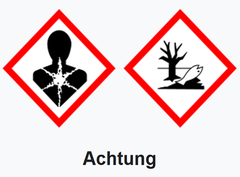Chlorparaffine (CPs): Analytische Rätsel und warum wir zuverlässige Standards brauchen [30.10.21]
Chlorparaffine sind Substanzgemische aus mehrfach chlorierten, gesättigten, unverzweigten Kohlenwasserstoffen, die aufgrund ihrer Persistenz und hohem Bioakkumulationspotenzial (Anreicherung im Fettgewebe, in der Niere und in der Leber) als umwelt- und gesundheitsgefährdende Stoffe gelten. Sie sind toxisch für aquatische Organismen und karzinogen für Ratten und Mäuse und stehen daher auch im Verdacht für den Menschen karzinogen zu sein. CPS wurden inzwischen weltweit in Böden, Gewässern, Sedimenten, Pflanzen, Tieren und Menschen nachgewiesen. Innovative Laboranalytik (incl. Massenspektrometrie und Kernspinresonanz) hat hier signifikante Fortschritte erzielt, eine verlässliche und vergleichbare Analytik bleibt jedoch aufgrund der laborabhängigen Variabilität von Ergebnissen sowie Einschränkungen bei kommerziell verfügbaren Standards eine Herausforderung. Ein europäisches Konsortium unter Beteiligung der Arbeitsgruppe von Prof. Walter Vetter beleuchtet verschiedene Aspekte der PC Analytik in drei aktuellen Publikationen.Originalartikel
Fernandes, A. R., Vetter, W., Dirks, C., van Mourik, L., Cariou, R., Sprengel, J., Heeb, N., Lentjes, A., & Krätschmer, K. (2022). Determination of chlorinated paraffins (CPs): Analytical conundrums and the pressing need for reliable and relevant standards. Chemosphere, 286, [131878]. doi.org/10.1016/j.chemosphere.2021.131878
Highlights
• Wide range of CPs (C10–C≤30) are detected, but existing standards have limitations.
• Urgent need for single-chain CP mixture standards for all chain lengths.
• Suitable individual congener (including labelled) standards (C10–C21) are required.
• Homologue-specific mixtures needed for instrument-independent quantitation.
Abstract
The determination of chlorinated paraffins (CPs) has posed an intractable challenge in analytical chemistry for over three decades. The combination of an as yet unspecifiable number (tens - hundreds of thousands) of individual congeners in mass produced commercial CP mixtures and the steric interactions between them, contrive to defy efforts to characterise their residual occurrences in environmental compartments, food and human tissues. However, recent advances in instrumentation (mass spectrometric detectors and nuclear magnetic resonance), combined with interlaboratory studies, have allowed a better insight into the nature of the conundrums. These include the variability of results, even between experienced laboratories when there is insufficient matching between analytical standards and occurrence profiles, the poor (or no) response of some instrumentation to some CP congener configurations (multiple terminal chlorines or < four chlorines) and the occurrence of chlorinated olefins in commercial mixtures. The findings illustrate some limitations in the existing set of commercially available standards. These include cross-contamination of some standards (complex CP mixtures), an insufficient number of single chain standards (existing ones do not fully reflect food/biota occurrences), lack of homologue group standards and unsuitability of some configurationally defined CP congeners/labelled standards (poor instrument response and a smaller likelihood of occurrence in commercial mixtures). They also indicate an underestimation in reported occurrences arising from those CPs that are unresponsive during measurement. A more extensive set of standards is suggested and while this might not be a panacea for accurate CP determination, it would reduce the layers of complexity inherent in the analysis.
Sprengel, J. , Krätschmer, K. , Vetter, W.
A new synthesis approach for the generation of single chain CP mixtures composed of a few major compounds
(2022) Chemosphere
Vetter, W. , Sprengel, J. , Krätschmer, K.
Chlorinated paraffins – A historical consideration including remarks on their complexity
(2022) Chemosphere


